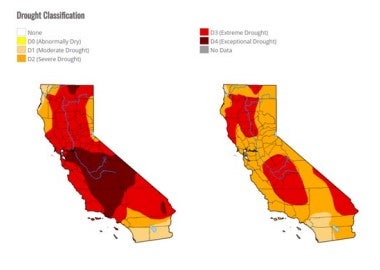The Drought Crisis
2021 was the driest year California has experienced in a century. At the end of the water year, spanning October 1, 2020 to September 30, 2021, the State received only 11.87 inches of precipitation, approximately half of average. This came on the heels of the second driest year on record in 2020. Lake Mead, a bellwether for predicting critical deliveries of Colorado River water to the State, has been declining since 2000 and reached its lowest level ever. California’s Lake Oroville and Lake Shasta reservoirs also reached critically low levels in 2021.
In response, Governor Gavin Newsom issued a series of drought emergency proclamations, beginning in April 2021. He called on Californians to voluntarily reduce their water use by 15 percent, and encouraged local agencies to rely on alternative water supplies and work with State agencies to identify solutions to shortages. At the end of the 2021 water year, Californians only achieved a five percent reduction in water use, and the drought emergency remains in effect.
The State experienced some hope that the drought might be ending in the first few months of the 2022 water year. The Sierra Nevada Mountains received more than 17 feet of snow near Lake Tahoe, Southern California is near 200 percent of normal precipitation, and the Northern Sierra region is at 154 percent of normal precipitation. However, projections indicate this will not be enough. Most of the State remains at severe drought levels, as depicted below, and key reservoirs are also still very low. California is also in its second year of La Nina, meaning that we may experience another dry year overall. California’s water resources remain uncertain over the long-term, and regulators will continue to closely monitor supplies.

U.S. Drought Monitor, comparing drought conditions in California between December 7, 2021 and March 15, 2022. (Available at, https://droughtmonitor.unl.edu/Maps/CompareTwoWeeks.aspx.)
Implementation of Groundwater Sustainability Plans Under SGMA
While drought conditions placed significant stress on California’s water resources, groundwater regulation efforts under the Sustainable Groundwater Management Act (“SGMA”) started to take full effect.
In 2014, Governor Jerry Brown signed SGMA into law, marking California’s first comprehensive approach to managing groundwater. Under SGMA, the California Department of Water Resources (“DWR”) identified high- and medium-priority basins, as well as critically over-drafted basins across the State. Local Groundwater Sustainability Agencies (“GSAs’) were formed to manage these basins and tasked with developing Groundwater Sustainability Plans (“GSPs”) to achieve basin sustainability within 20 years. GSAs managing basin areas designated as critically over-drafted were required to submit their GSPs to DWR by January 31, 2020. The deadline to submit GSPs for the remaining basins covered under SGMA was January 31, 2022.
GSAs may adopt a single plan for covering an entire basin, or combine a number of plans created in cooperation with multiple agencies. While GSPs are under review, GSAs are required to begin implementing their terms. DWR has two years from the date of submission to evaluate each GSP for compliance with SGMA, and determine whether they are likely to achieve sustainability goals. DWR makes one of three determinations for each GSP reviewed: approve, incomplete, or inadequate. If approved, the GSA must continue to implement the GSP and gather information to fill data gaps. If a GSP is deemed incomplete, the GSA has 180 days from the date of DWR’s notice to work with local stakeholders, correct deficiencies, and resubmit a revised GSP. If a GSP has been deemed inadequate, DWR will consult with the State Water Resources Control Board, which has the authority to intervene and manage the basin.
To date, DWR has received 112 GSPs covering nearly all highand medium-priority basins, and critically over-drafted basins. DWR approved six GSPs between June and November 2021, and recently approved two more on January 13, 2022. These approved GSPs apply to basins in the Counties of Ventura, Yuba, Santa Cruz and Monterey. DWR also made findings that 34 GSPs, mostly covering basins in the Central Valley, were incomplete. So far, no GSPs have been deemed inadequate. The remaining GSPs are still under review, and DWR will continue to release the official determinations of those plans within the next two years by January 2024. DWR also has an on-going role under SGMA to review annual progress reports from GSAs and assess approved GSPs every five years to determine whether they are on track to meet objectives.
Recent SGMA Litigation
While GSAs worked to draft and submit their GSPs, litigation followed as stakeholders challenged the approaches to basin management. Among the 42 GSPs that have been submitted to DWR, at least four are being litigated in California Superior Courts. So far, these lawsuits are not concentrated in a particular region of the State, with challenges in the Central Valley, Central Coast, and eastern desert regions. A common theme raised in each of the complaints is the allegation that the various GSAs violated SGMA by adopting GSPs that changed the rights and priorities of water rights holders within the basin areas. Under Water Code Sections 10720.5 and 10726.8, SGMA expressly forbids modifying water rights or their relative priorities, and reserved the authority to make such determinations to the courts.
One case in particular, California Coastkeeper Alliance v. County of Sonoma (Case No. SCV-268718), filed in the Sonoma County Superior Court stands out because it asserts that SGMA is not the sole mechanism for groundwater regulation. The petitioners are asking the court to compel the County of Sonoma to cease issuing permits for drilling groundwater wells in order to mitigate impacts of pumping on the flow of the Russian River. Relying on Environmental Law Foundation v. State Water Resources Control Board (2018) 26 Cal.App.5th 848, they argue that the public trust doctrine provides another means by which the County has a duty to protect the watershed from groundwater extraction.
As these cases make their way through the courts, the decisions will help delineate the extent of GSAs’ authority to determine who gets to pump groundwater, how much, and under what circumstances. Meanwhile, there will likely be more challenges to new GSPs that will be implemented in the coming months. Interest groups relying on the public trust doctrine may also seek to compel other local agencies to implement other strategies to curb groundwater extractions in basins and watershed areas not covered under SGMA.




 />i
/>i

